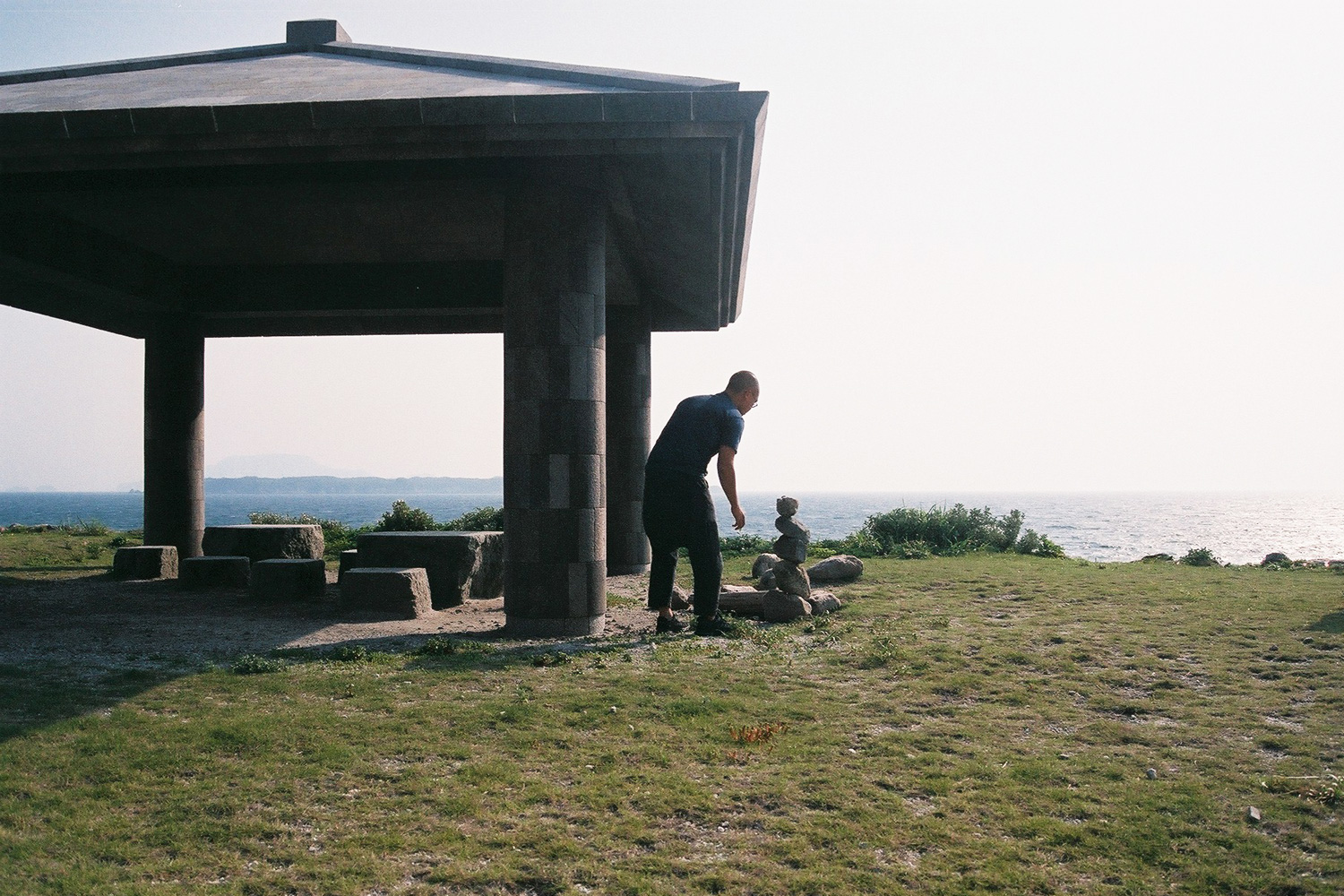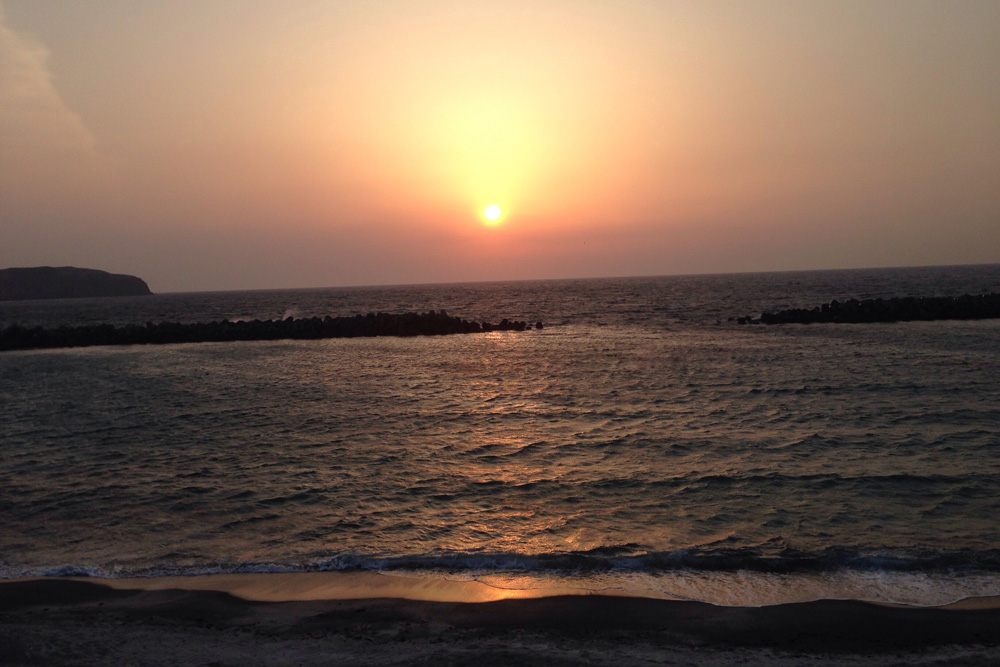Saro
After two hours and twenty minutes (made bearable with the ever reliable companionship of Asaf Avidan, Disclosure, Jaime xx, Justin Timberlake, Of Monsters and Men, World’s End Girlfriend, all in random order) it was finally time to depart the Tokai Kisen’s Yumi (Dream) jet boat, which we had boarded in Tokyo at the Takeshiba Ferry Terminal.
A young and slim lady was standing by the port, holding a large wooden board with the word “saro” painted on it (the Japanese make great signs but that is another story for another day). She looked fun in a light denim jumper, large curly brown hair and a wide warm smile that matched the new weather and scenery we had arrived to. It was Spring but slightly warmer compared to what we were experiencing in Tokyo. The sea breeze was cool, but not chilly. It smelt like salt water. We had arrived at the volcanic island, Niijima.
Niijima Island
The view from the beach
We walked over and introduced ourselves, her name was Fujiko. "We have to be at the airport to pick up another guest, do you mind?" she asked with confidence and the much expected politeness. "No, not at all," we said–it was not like we had anywhere else to be.
Fujiko was taking us to saro, a five-room minshuku we had booked. By definition, a minshuku is a type of traditional and family operated guest house which provides bed and breakfast, located in smaller cities or islands that are too small for a fully operational ryokan or hotel. However, the experience received is comparable to that of a ryokan, where simple meals are provided and guests can also enjoy conversations with the owner.
Created by Japanese entrepreneur, Yoichiro Takano, saro is a modern take on minshukus, designed to fulfill Yoichiro’s purpose to help guests forget the hustle and bustle of life and take time on an island that cherishes slow life. “I enjoy building relationships with people, existing in the form of a little dream in someone else's life makes life worth living for me.” he shares.
saro's bar
“The biggest challenge was to ensure that the audience would come. I understand that business is generally unpredictable but I have been telling myself that it is alright as long as I do a good job,” he reveals his humble intentions. In its fifth year running, saro was fully booked on a couple of earlier dates that I had requested for. Not so bad afterall.
Fujiko pointed us to the vehicle–a boxy Japanese van that fit perfectly on the tiny roads, with a careful and amicable driving demeanor that is. On the way to the airport, we quickly learned that Fujiko was working for saro temporary until the end of autumn when she will leave for Australia, again–she spent a good couple of years in Sydney some time back. Despite our first meeting, her cheerful and optimistic free spirit was rather contagious.
We stopped by the super compact airport and picked up a young Japanese family. It is also possible to arrive at Niijima by taking a domestic flight from the Chofu Airport by a small domestic plane that would take up to forty minutes. A couple and their toddler greeted us and we soon discovered that a triathlon was taking place a couple of days later and Daddy was participating. On hindsight, Niijima is perfect for long distance runs with the relatively empty roads that lead to many rewarding sceneries.
On the road, walking alongside the beach
We arrived at saro approximately 10.30am. Standard procedures applied, we took off our shoes and were more than happy to change into the comfy soft and grey room slippers. We were invited to sit down at the "lobby", check in was fuss free–there was nothing to do except admire the space for the very first time and sip on ice cold tea.
“I think a good hotel balances between location and price. If a hotel is priced at USD500, you will need brilliant furniture and luxury services such as a first-class chef. As a small inn on the island, “luxury” does not apply similarly. “Luxury” here is enabling our guests to spend time at ease by providing good food and a cosy atmosphere, as if entertaining an old friend at home. To treat guests like family is very important to us,” Yoichiro shares his homely philosophy on hospitality.
“I hope that people who come to saro can spend time leisurely. People living in Tokyo are constantly chasing something: work schedule, time of train, meeting someone or buying material things. If you are in Niijima, there is no place to be, no appointments to make, so you can do whatever you like: take a nap in the room, have a beer in the garden, drink coffee, read a book and talk to a loved one while watching the sunset.” he explains his vision for saro.
While waiting for our room to be ready, music was flowing, piano keys uplifting. “The music we play do not contain lyrics, so that it inspires various thoughts in different people. Ryuta’s music was playing in a shop I entered by chance. I liked it and purchased the album,” Yoichiro explains. The music of Ryuta Iwamura’s Sunday Impression filled the space, we had never heard it before but it felt familiar.
It was a team of five, including Yoichiro. Two showed guests around and handled the check in process while three were in the kitchen preparing the day’s dinner. Shortly after, Fujiko showed us to our room upstairs. The overall interior of saro had a strong modern-traditional Japanese build up with an underlying Western influence. It was comfortable. I felt at ease. The place was aging with grace, and it was our home away from home for the next three days.
We headed out for sushi located fifteen minutes away by foot, before spending the rest of the day in saro's living room, on the hammock, or the armchair, swapping positions once in awhile, flipping magazines and reading books (great taste in publications), drawing and doodling, lazing and napping, people and cat watching, completely relaxed without a care about what was happening in the world. We were free and there was lightness in being.
Niijima Island itself had a calming effect on its inhabitants. When we were not in saro, we were out chasing the slow life and experiencing the minimal population. Days were spent cycling around the island with strong wind ringing in our ears, making occasional stops by the onsens, witnessing glass blowing at the Niijima Glass Art Center and not to forget the beaches. There is a beach on each end of the island, both equally clean with ash grey sand and clear waters. Before nightfall, we would chase the sunset and return to saro for dinner.
Live demonstration
Work in progress at Niijima Glass Art Center
Sunset at the Maehama Beach
“There is not much food in Niijima so we create our daily menus through what we can find in Niijima,” Yoichiro shares. Dinner differed daily and was often an exciting affair. There is a certain charm in not knowing what was going to be served and not having to make a single decision except coffee, tea or beer. Life was good.
Breakfast–french toast, oatmeal yoghurt, pineapples with freshly dripped coffee
Breakfast view
Perhaps it was the quietly spectacular meals that differed daily, or the uniformity of the 8am breakfasts, 12pm lunches and 7pm dinners–for a long time I had forgotten consistency in meal times and the art of a well balanced meal–it was rejuvenating to be reminded of the fortunate circumstances that we had been blessed with. During the nights, we slept soundly breathing in the sea breeze with windows open, air conditioner turned off, waking up daily to perfect sinus-free mornings.
Morning view
Lunch–creamy tomato spaghetti (al dente) with super fresh shrimps
The other option, the way too good taco rice
The time we spent at saro felt more like being in a friend's summer house. Yoichiro has managed to build a business model centred on the values that he strongly believes in. This year, Yoichiro is curating his first show in saro–a solo exhibition of Takumi Yashima’s works. He intends to extend the exhibition to 108, a café that he also runs in Tokyo. “We have made many friends in Niijima island and then met them again in 108,” he quips.
On off days, he likes to appreciate life for the simple things, “I have a cat named Chobi. He is living with my mother at home. I enjoy going back once in a while just to spend time with the happy cat. Chobi is now 6 years old. I think cats live longer when they are brought up with love. I wish to live in gentle moments like these forever.”

























